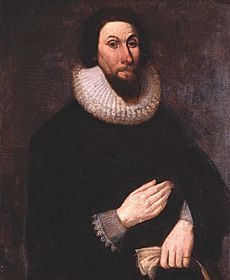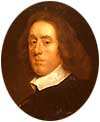Matthew Cradock facts for kids
Quick facts for kids
Matthew Cradock
|
|
|---|---|
| Governor of the Massachusetts Bay Company | |
| In office 1628–1629 |
|
| Succeeded by | John Winthrop (as Governor of Massachusetts Bay Colony) |
| Personal details | |
| Born | unknown |
| Died | 27 May 1641 |
| Political party | Roundhead |
| Signature | |
Matthew Cradock (sometimes spelled Craddock or Craddocke; died 27 May 1641) was a rich merchant and politician from London. He was the first governor of the Massachusetts Bay Company. This company was started in 1628 by Puritan businessmen. They wanted to create a new settlement in North America, which became the Massachusetts Bay Colony.
Even though Matthew Cradock never actually visited the colony, he owned land and businesses there. He worked from London to help the colony grow. His trading business was huge, with at least 18 ships. He traded goods from the West Indies and North America all the way to Europe and the Near East. He was especially important in the tobacco trade.
Cradock was a strong supporter of the Parliamentary cause before the English Civil War. He disagreed with the king's supporters in the East India Company. As a member of the Long Parliament, he wanted to make big changes to the Church of England. He also played a key role in the Protestation of 1641, a public statement of loyalty to Parliament. He died soon after this event.
Contents
Who Was Matthew Cradock?
Not much is known about Matthew Cradock's early life. He came from a family in Staffordshire, England. One of his cousins, also named Matthew Cradock, was the mayor of Stafford. Even though Matthew's father was a church leader, his grandfather was a merchant, and other family members were involved in trade.
Matthew Cradock was married twice. With his first wife, Damaris, he had a daughter, also named Damaris. With his second wife, Rebeccah, he had three children, but they sadly did not survive. Rebeccah lived longer than him, but his will doesn't mention any children from his second marriage.
Matthew Cradock's Business Life

In 1606, Matthew Cradock started as an apprentice at the Skinners' Company, a big shipping company in London. He likely began trading with countries in northwestern Europe. Over time, he expanded his business to the Near East.
Cradock joined the Levant Company in 1627. In 1628, he bought a lot of stock in the East India Company. He served as a director for the East India Company from 1629 to 1630, and again from 1634 until he died in 1641.
Cradock used his business connections to create a very profitable trade. He shipped tobacco from the New World to the Near East. He also sent supplies to the colonies in North America and the West Indies that grew the tobacco. Between 1627 and 1640, he owned or partly owned 18 ships. He was one of the few businessmen who traded both with the East (India and the Levant) and within European waters. By the late 1630s, he was at the center of one of the biggest trading businesses involved with the Americas.
In 1640, Cradock and other businessmen tried to change the leadership of the East India Company. They wanted to make it less focused on the king's ideas, but they were not successful.
Starting the Massachusetts Bay Colony
After the London Company failed in 1624, many London merchants lost interest in starting colonies in North America. The Colony of Virginia then became a royal colony, directly controlled by the king. Matthew Cradock was different; he remained interested.
As a Puritan, Cradock invested a lot of money in the New England Company in 1628. This company was formed by Puritan religious and business leaders. They took over what was left of the Dorchester Company and planned new ways to settle North America.
On May 13, 1628, Cradock was chosen as the company's first governor. Soon after, the company received land on Massachusetts Bay from the Plymouth Council for New England. They sent John Endecott with a small group of settlers to start a colony in a place now called Salem, Massachusetts.
The land grant had a problem: it overlapped with land that John Oldham had already claimed. Cradock wrote to Endecott in early 1629, warning him about this issue. He suggested that Endecott settle colonists in the disputed area and treat the Old Planters (the remaining settlers from the failed Dorchester Company) well. Cradock also advised the colonists to build ships and focus on other activities that would make money. Later in 1629, another small group of ships sailed for the colony. On board were not only Puritan settlers but also skilled workers for Cradock's businesses.
To protect its land claims, the company got a royal charter in 1629. Under this charter, Cradock was named the colony's governor in London, while Endecott governed in the colony itself. That same year, the government was having money problems because King Charles I wanted to fight a war with Scotland. The company's investors worried their money might be at risk.
At a meeting in July 1629, Cradock suggested that the company move its main office and leadership to the colony itself. This was possible because the charter didn't say where the company's meetings had to be held. However, some investors, including Cradock, didn't want to move to the colony. So, they needed a way for those who stayed in England to sell their shares.
After discussions through the summer, an agreement was reached on August 29, 1629. It said that shareholders who moved to the colony would buy out those who stayed in England after seven years. Those who stayed would also get a share of some of the colony's business, like the fur trade. John Winthrop, one of the shareholders who was moving, was elected the company's governor in October.
Winthrop sailed to Massachusetts in 1630. His fleet included two of Cradock's ships, along with Cradock's agents and workers who would manage his businesses. Cradock said goodbye to the settlers at the Isle of Wight and stayed in England.
Cradock's representatives secured a large farm for him in Medford. This became a base for Cradock's business operations, including the colony's first shipyard. As the colony grew, Cradock's land expanded to include properties in Ipswich and Marblehead.
Even though he didn't go to the colony, he continued to help it from London. In 1629, he worked to convince Puritan ministers who agreed with their ideas to move to the colony. He asked the king's Privy Council for permission to freely send supplies to the colony. He said the colonists were in great need and faced threats from Native Americans. He and Governor Winthrop exchanged letters. In one letter from 1636, Cradock promised £50 to help start a higher learning institution, which is now known as Harvard University.
In 1633, some people questioned the actions of the Massachusetts Bay Colony leaders before the Privy Council. Opponents of the Puritans claimed the colony's leaders wanted to be independent from England. Cradock and other company representatives were called to answer these claims. They successfully defended the colonists' actions. However, the Puritans' opponents did manage to stop ships full of colonists from sailing in February 1633/4. They demanded that the colonial charter be shown to the council.
Cradock was asked to provide the charter. He told the council it was in the colony and got the ships released by promising to have the charter delivered. The colonial council in Boston didn't want to send the document, fearing the charter would be taken away. They delayed, saying in their July 1634 meeting that the document could only be released by a vote of the colony's General Court. This court wasn't scheduled to meet until September. When it met, the General Court refused to consider the issue. Instead, they began building defenses around Boston Harbour, expecting a military fight. A ship meant to carry troops to the colony failed to launch in 1634, ending the military threat. However, political threats continued, and the charter of the Plymouth Council of New England, which had given the colony its land, was taken away.
In 1635, some serious accusations were made against Cradock and others connected to the Massachusetts Bay Company. Cradock was found innocent of most of these. However, he was found guilty of using authority he didn't have and lost his ability to act for the company.
Cradock's Role in Politics
In 1640, Matthew Cradock was an auditor for the City of London Corporation. In April 1640, he was elected to represent the City of London in the Short Parliament. He was elected again to the Long Parliament in November 1640.
He and other London Members of Parliament were allies of Sir Henry Vane the Younger, who supported Parliament. Cradock supported the Root and Branch petition, which called for big changes to the Church of England. In the first meeting of the Long Parliament, he spoke out against the king's plan to fortify the Tower of London. He stated that the city would not pay its share of taxes until the soldiers were removed.
In early May 1641, Cradock brought news to Parliament that the king was planning to send armed troops to take the Tower of London. This news led to the Protestation of 1641, where Cradock played a leading role. He continued to be active in Parliament, serving on a committee for people who refused to follow the Church of England, until his sudden death on May 27, 1641.
Cradock's Family Life
Damaris, Matthew Cradock's daughter from his first wife, first married Thomas Andrewes. He was a citizen and a member of the Worshipful Company of Leathersellers in London. Thomas was the son of Sir Thomas Andrewes, who was the Lord Mayor of London in 1649 and again from 1651-52. Damaris and Thomas had several children. Thomas Andrewes died in 1653.
After Thomas died, Damaris married Ralph Cudworth. He was a very important person in a group called the Cambridge Platonists and was the Master of Christ's College, Cambridge. With Ralph, Damaris had three more sons and a daughter, Damaris Cudworth, Lady Masham. Matthew Cradock's daughter, Damaris Cudworth, passed away in High Laver, Essex, in 1695.
Rebeccah Cradock, Matthew's second wife, married twice after his death. First, she married Richard Glover. Her last marriage was to Benjamin Whichcote, another important figure among the Cambridge Platonists. He was the Provost of King's College, Cambridge and a close friend of Ralph Cudworth. Both Cudworth and Whichcote were also close with Matthew Cradock's nephew, Samuel Cradock (who was a student of Whichcote's). Samuel's brother, Zachary, was the Provost of Eton College. Cudworth, Whichcote, and the Cradock brothers had all studied at Emmanuel College, Cambridge.



